- 1Department of Psychology, St. Mary’s University, San Antonio, TX, United States
- 2Environmental Science, St. Mary’s University, San Antonio, TX, United States
Engaging undergraduates in publishable research is challenging. Skills including researching topics, statistical knowledge, and writing abilities are necessary; however, students often face time constraints or financial challenges that impede them from engaging in these experiences. Conducting research with underrepresented students can be an even bigger challenge, as these groups are known to face additional financial or family burdens that the traditional student does not face. This essay reports on the development of an international field study with the goal of producing publishable research by undergraduates. To date, 27 students (68% Hispanic, 52% first generation) have participated in a week-long immersion field experience in Roatán, Honduras. As an interdisciplinary field study, students were exposed to animal behavior, ecology concepts, and research methods through a two-course sequence that incorporated the field experience. In this essay, we share our best practices for conducting a field study with students from underrepresented populations with the goal of producing publishable research. We include the evolution of the course curriculum that was informed by self-reported student experiences and a brief description of some of the projects students designed. Students reported that the field experience highlighted the importance of adjusting research plans and expectations. Ultimately, this program exposed students to advantages and disadvantages of conducting field research while increasing confidence in their ability to conduct effective and meaningful research. A minimum of two semesters may be needed to create publishable research projects and 1 week of data collection is not sufficient for successful research projects.
Introduction
Engaging undergraduates in research at a minority-serving institution has many challenges. Competing factors such as family expectations, financial constraints, lack of awareness regarding the importance of research, and the underdevelopment of critical research skills are some of the obstacles encountered by faculty working with underrepresented students (Ortiz, 2004; Bridges et al., 2008; Kuh, 2008; Bangera and Brownell, 2014). These obstacles may be amplified if the institution is also a primarily undergraduate teaching university, where research is expected of faculty in addition to teaching and service duties, but the financial support for research may be lacking (Smith and Brown, 2012; Anastasio, 2016). However, high impact practices such as field studies and immersion experiences are known to be both transformative and productive for participants and need to be encouraged for all students, regardless of circumstances (Barnett, 1997; Lopatto, 2007; Jones et al., 2010; Kuh et al., 2010; Finley and McNair, 2013; Bangera and Brownell, 2014). Our research immersion program combines curriculum-based research with an international, field immersion experience. The purpose of this essay is to share our best practices for conducting an interdisciplinary, week-long, international field immersion study supported by curriculum-based research experiences with the goal of collecting data for a publishable research project.
Logistics of the Field Course
To date, we have completed two field studies on the island of Roatán, Honduras with a total of 27 undergraduate students, including two repeat students. Of the 25 unique students, 68% self-identified as Hispanic, and 52% as first generation/low income. Our institution, St. Mary’s University located in south central Texas, serves over 2,000 undergraduates and is a Hispanic Serving Institution (HSI) with a high percentage of first generation and low-income students. Our recruitment efforts reflect the distribution of our university and the disciplines of the two authors. The field study is interdisciplinary with emphases on comparative psychology and environmental science, and students had the opportunity to design independent research projects involving animal behavior and cognition with bottlenose dolphins as the study animal, or conservation biology/environmental science topics related to the marine environment. The majority of the students had taken either statistics and/or research methods courses or have been involved in smaller, independent research projects prior to attending the field study. Completing at least one of these courses or a previous research experience is necessary for students to create a research study that is publishable. The field study has gone through two iterations thus far with important lessons learned from the inaugural field study that were then implemented in the second iteration to try and increase the likelihood of successfully completing a publishable research project (Figure 1 illustrates the two iterations).
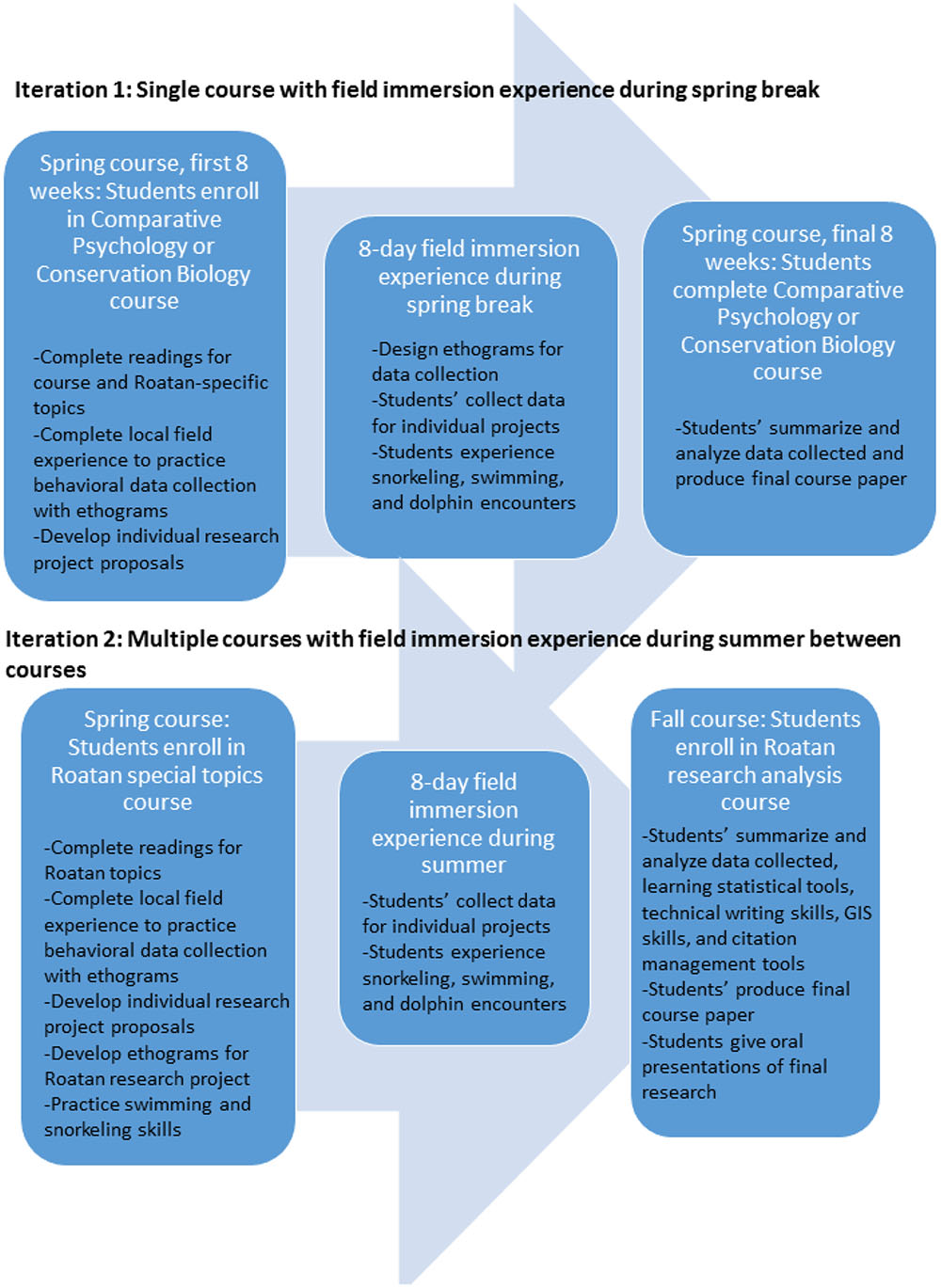
Figure 1. Flow process of Iteration 1 and 2. Neither iteration resulted in publishable research, mainly due to quantity and quality of data collected. However, Iteration 2 enabled the students more time to conduct the necessary background research, learn essential research skills, and practice presenting their research in an oral format. Based on feedback from the students’ in each iteration, and the progress made in research skills and results in Iteration 2, we recommend future experiences incorporate longer field immersion experiences.
Iteration 1
In the first iteration, we had 13 students, of which 9 identified as Hispanic and 1 additional identified as non-Caucasian; all 13 were female. The students took either conservation biology or comparative psychology in the spring semester, which was paired with a laboratory course that consisted of the field study during spring break. Both courses were coordinated prior to spring break so that students in each course attending the field study could learn the skills necessary to complete their research projects while in Roatán. The students who were not attending the spring break field study completed similar research projects but with local resources (e.g., local zoo, campus, or surrounding natural parks and reserves). Students in both classes read original, peer-reviewed scientific literature on topics involving animal behavior that targeted constructs that could be examined in the field, conservation issues and efforts (with special emphasis on the tropics), ecological diversity, and research methods for behavioral and environmental sciences. With guidance from the coordinator of the field study and the two authors, the students also developed research proposals for projects to be collected during the 6-day field immersion period. Students developed their projects independently of one another, although topics and data collection methodology could overlap. Example project topics included: Species diversity of seagrass in Anthony’s Key and Bailey’s Key in Sandy Bay, Roatán, Honduras; and type and frequency of play behavior by dolphins and frequency of pair swims in same-sex and mixed-sex dolphin dyads. Once in Roatán, all students assisted on data collection for all projects so that they could be cross-trained on the different methods employed by each discipline; however, each student was using the data collected for their own, unique research project. In addition to data collection for their projects, the field study experience included lectures, discussions, and special presentations by local educators and trainers on topics unique to the island and marine ecosystem, snorkeling, and kayaking every day. Following the field study, the participants and their classmates completed their data analyses and formal write-ups as the final project requirement of the two courses. Ideally, any of these projects could have been publishable if enough data had been gathered. Unfortunately, given the individual nature of the projects and the time available to collect data during the field study itself, the majority of the projects did not have sufficient data to warrant a publication. However, several of the projects were presented at our university’s symposium that spring and one conservation biology project investigating soil and water quality on Roatán was presented at an international conference, earning an outstanding undergraduate research award and travel grant.
Iteration 2
Based on the semester-long style for iteration 1, which is a common approach for many field studies, and the feedback provided by the 13 students, we modified the format and required a two-semester commitment by the students participating in the field study. We had 14 students in the second iteration, of which 9 identified as Hispanic and an additional 1 identified as not Caucasian, and we had 10 females. The first semester, the field study students enrolled in a special topics course for 3 h of credit in the spring. The format of this course was the same as in the first iteration, meaning that all required reading was completed before attending the field study (which had been a challenge in the first iteration since the field study occurred 8 weeks into the semester), and students were required to develop their individual research projects in collaboration with another classmate or two. At the end of this first course, students had a well-defined plan for data collection and an independent research proposal. All proposals had been guided and were approved by H. Hill and M. Karlin, the instructors of the field study. Example project topics included: Estimating marine specie richness and evenness of seagrass habitat in Roatán, Honduras; and activity level of dolphins before, during, and after the presence of a swimmer or number of dolphins in a designated safe zone area during a swim program. The field study itself occurred later in the summer the week before the fall semester began. Upon the students’ return from the field study, students began a second special topics course, which emphasized advanced research methods and ended with a drafted research manuscript and oral presentation. Students were also required to present their field study research in either oral or poster format at the university’s research symposium in the spring following the field study experience.
Summary of Student Experiences
All students in both field studies completed a post-field study survey immediately at the end of the week. The second field study students also completed a pre-field study survey at the beginning of the spring semester course. The surveys included questions specific to the program we developed as well as four previously validated instruments: Interest in Research Questionnaire (Bishop and Bieschke, 1998); Research Self-Efficacy Scale (Greeley et al., 1989); general self-efficacy (NGSE, Chen et al., 2001); New Ecological Paradigm scale (NEP, Dunlap et al., 2000). The student free responses supported previous research findings for international immersion experiences (Barnett, 1997; Lopatto, 2007; Jones et al., 2010; Kuh et al., 2010; Finley and McNair, 2013; Bangera and Brownell, 2014): our students reported testing and pushing their personal boundaries and comfort zones while increasing their confidence and becoming more aware of the culture, economy, and pressures of those in the country they visited (Tables 1–4). The results from the quantitative data from these surveys are available for review (Karlin and Hill, unpublished). Many of the students reported that the field experience highlighted the importance of adjusting research plans and expectations (Tables 1–4). Whether the students developed their ethograms for data collection during the first 2 days of the field study (first iteration) or prior to the field study (second iteration), all the students had to modify their selected research projects to account for field conditions. Having never conducted their own research study or developed a study with live subjects in an ever-changing field conditions (e.g., weather changes, availability of animals for data collection, access to locations for data), all the students reported being overwhelmed initially (Tables 2–4). During and following both field studies, the students reported that working in a small group setting with peers that were conducting similar research helped them to develop, refine, and implement their projects more successfully. Example responses from the post-survey responses include (Tables 1–4): “This study offered experiences that one may not normally have the time or money to do after he/she has graduated from school.”; “This field study was absolutely transformative, I was able to gain critical research experience while also making lots of new friends and priceless memories.”; “… I feel like my learning capabilities have transformed into something much bigger than a classroom.”
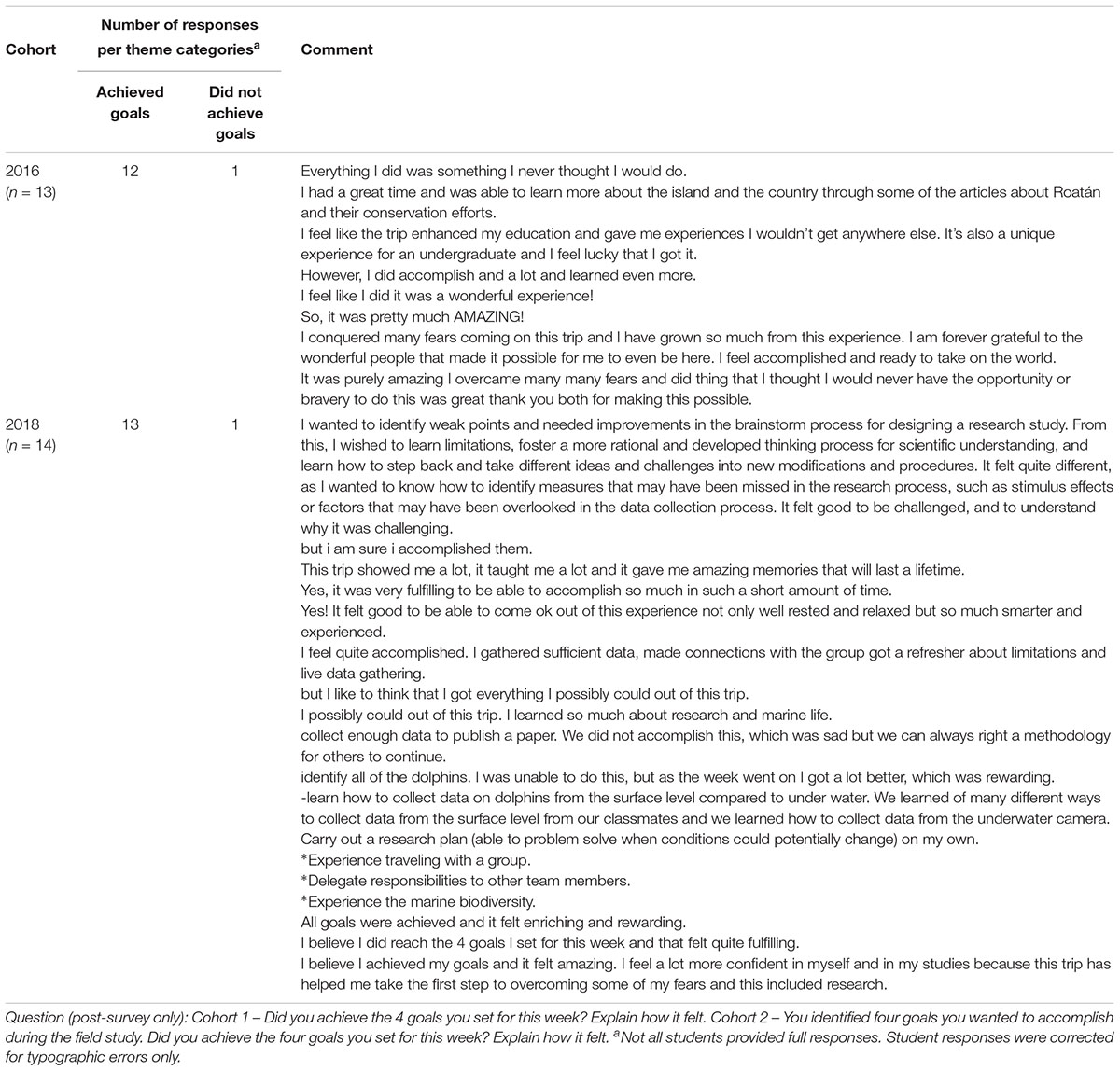
Table 1. Summary of themes and comments produced by field study students regarding goal achievement.
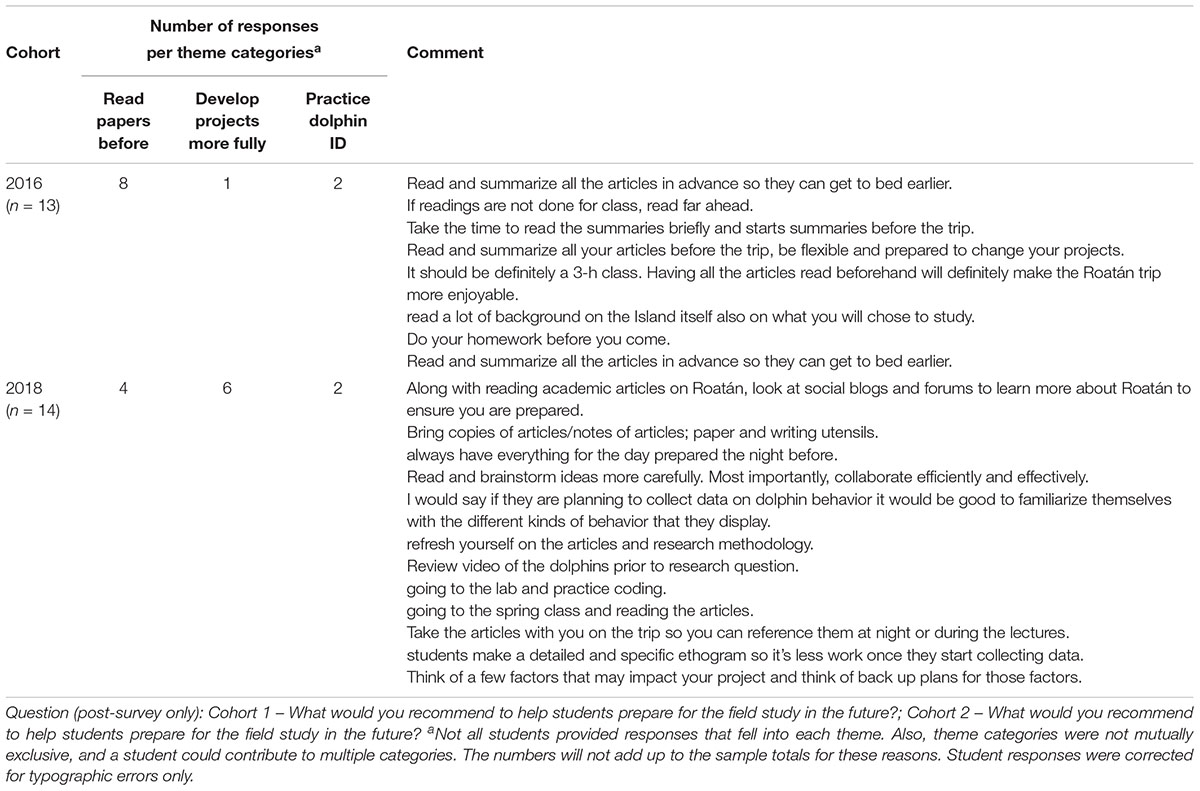
Table 2. Summary of themes and comments produced by field study students regarding preparing for the field study.
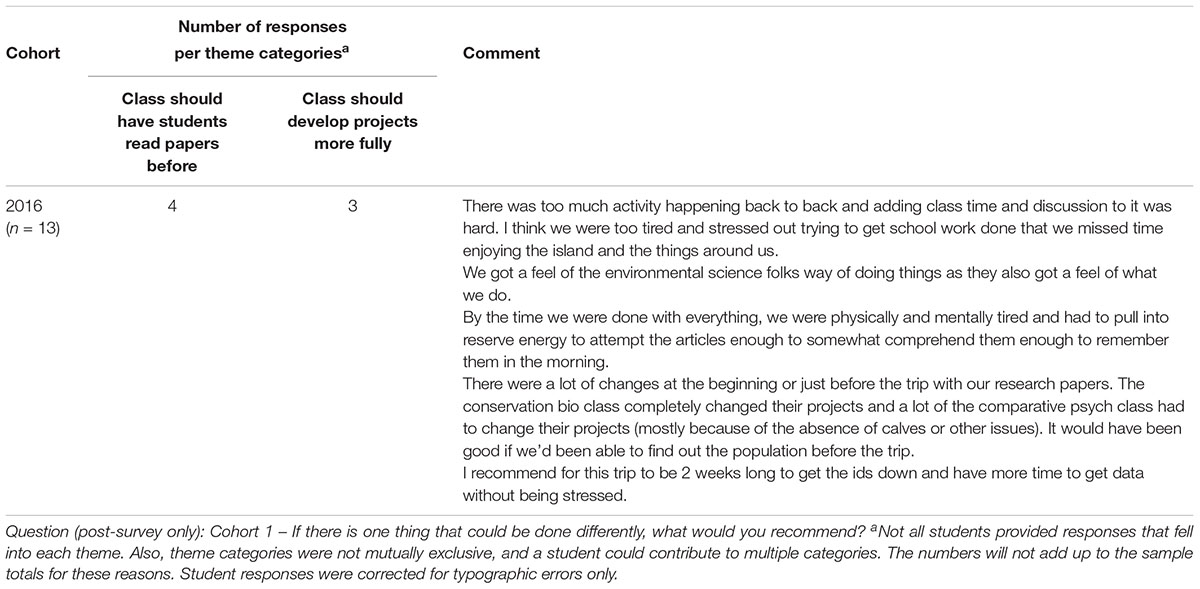
Table 3. Summary of themes and comments produced by field study students cohort 1 regarding recommended changes to field study.
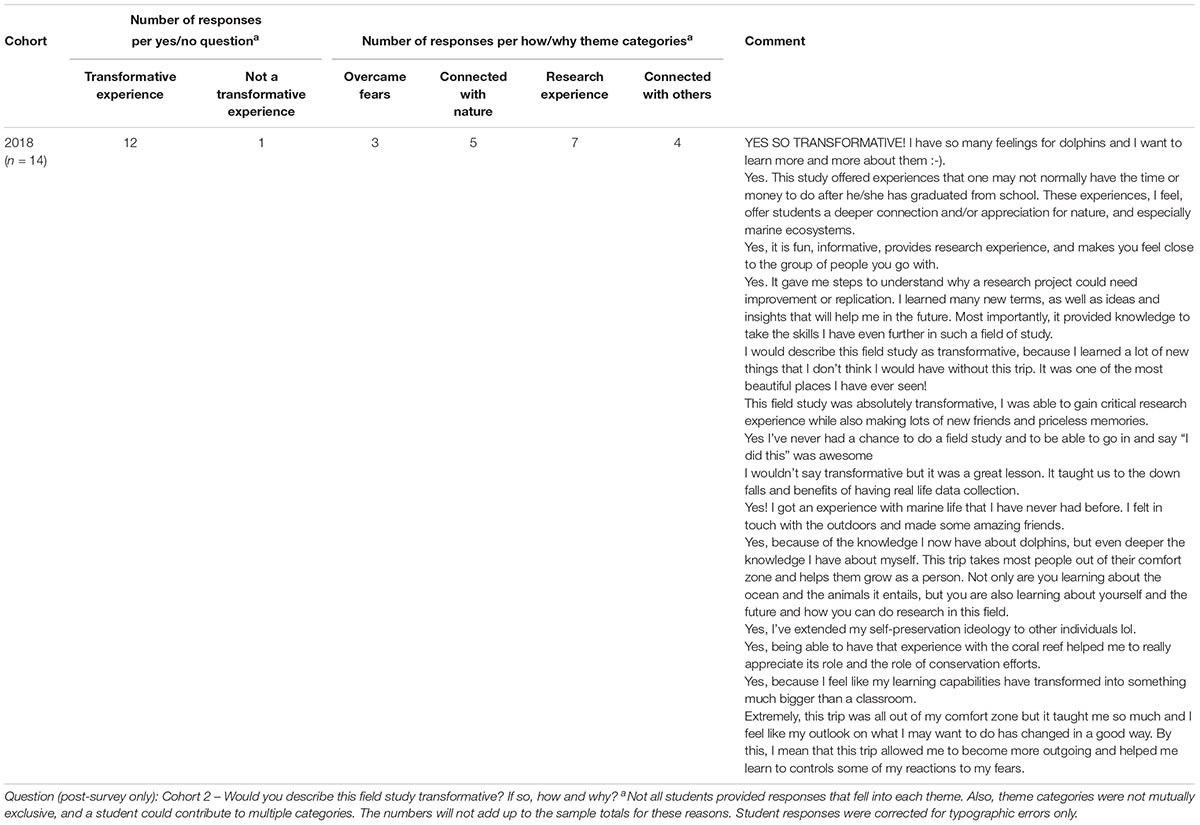
Table 4. Summary of themes and comments produced by field study students cohort 2 regarding the transformative nature of the experience.
Financial Considerations
During iteration 1, the program fees were incorporated into the laboratory course fee that only the students participating in the immersion experience were enrolled. Therefore, students were able to use their financial aid packages to cover the expenses associated with the experience. Students also held a number of fundraisers prior to the immersion experience, to try and offset some costs. The amount of money raised was minimal; however, it did help to bring the students together and work as a team prior to the trip to Roatán.
During iteration 2, the program fees were incorporated into the spring Roatán class that only the student attending the immersion program were enrolled. Like iteration 1, this meant that the students could use their financial aid packages to cover the costs. However, unlike in iteration 1, the authors wrote and were awarded an internal research grant, the purpose of which was to report on the successes of creating this immersion program. The majority of this award was diverted to the students enrolled in the immersion program to help offset some costs (approximately 20% of the total costs per student).
Lessons Learned
Ultimately, these two field immersion courses point to the conclusion that to produce a publishable research project, the students need a minimum of two semesters to refine skills previously learned in pre-requisite courses/research projects, develop the research project, analyze the data, and write an initial draft of the paper. Highly motivated students may be able to complete a final publishable product by the end of the second semester with a course devoted to preparing the paper, but most students will likely need a third semester devoted to revising and refining the initial draft to prepare for submission to a journal. Moreover, the data collected during a week-long field study that involves so many other components (in this case, snorkeling trips, discussions, lectures, data processing time) is not sufficient time for meaningful parametric analyses, which then means students must learn about non-parametric statistics while trying to process their data. This limitation may be addressed if students work as teams and collect data across multiple individuals, but this solution has its own issues, namely reliable data collection. It took the students 2 days of practice before they were comfortable with collecting data officially for the project, which limited their data collection opportunities. No publishable research resulted from either iteration (Figure 1). We believe that the students’ can develop successful research ideas; however, the key is the amount of data collected and how much time is spent in the field immersion. Based on our results after 2 iterations, we are recommending at least 2 weeks of data collection, in addition to allowing students to work in groups. These modifications will allow for additional time to collect data, and additional division of data collection amongst the group members, ultimately increasing the sample size of their data. Several students identified working as part as a group one of the elements they considered helpful. The additional time will also partially alleviate issues with uncontrollable field conditions. In our field study, the students were allowed to collect data in teams because their targeted datasets often overlapped, but they had to develop their own hypotheses so that they could write individual papers. It may have been more efficient to allow the students to work as a team on the same project topic as well as for writing the final research paper. Previous research has suggested that working in teams facilitates the research process and makes it less overwhelming (Love et al., 2007).
Future Directions
Overall, the field immersion experience at an international location has been met with enthusiasm and increased interest by our student population, which is majority minority and underrepresented. In addition to self-reporting increased confidence in their research abilities and enthusiasm for conducting field research (reported in the qualitative comments presented in this essay and the quantitative data Karlin and Hill, unpublished), the international setting and novel experiences led students to report being surprised at the unexpected bonds they developed with their classmates in such a short period (Tables 1, 4). To increase diversity in field study or research experiences, we recommend that instructors recruit from underrepresented student-serving programs such as McNair, MARC-U∗STAR, or other TRIO support programs. If instructors give students at least a year to plan for a similar experience, the financial burden can be alleviated by spreading out payments or using financial aid. Some study abroad offices also offer scholarships.
Incorporating a special topics course that was dedicated to the field experience itself was critical in both preparing the students for the field experience (e.g., practice swimming and snorkeling) and developing the research projects more fully. While having the pre-requisite class of either comparative psychology or conservation biology with a laboratory course (iteration 1) was helpful, we found that students felt rushed and more overwhelmed trying to read all of the field study content and prepare a proposal at the same time as managing the rest of the course content in the first 8 weeks of the semester (Figure 1 and Tables 1–3). This iteration was not conducive to creating publishable data (i.e., insufficient data collection period, minimal manuscript preparation time). By requiring a two-course sequence with recommended pre-requisite classes/experiences (e.g., statistics, research methods, comparative psychology, conservation biology, relevant research experience), the second iteration was more successful in creating projects that were potentially publishable. Even with the changes employed in iteration 2, we still had issues with students having sufficient data for a publishable manuscript.
Becoming engaged in a research project, having the time to devote to sufficient data collection, and then writing a publishable paper on an original research project is extremely challenging for upper-division undergraduates in general, and especially at schools with characteristics such as ours. Having the second full semester allows the students to develop their projects more formally for the potential to publish in an external research journal, if they collected sufficient data during the field study. In response to these two experiences, our next iteration will involve a three-course sequence with the field study and data collection experience occurring immediately after the spring semester rather than immediately before the fall semester. The first course will be either comparative psychology or conservation biology, which will be the pre-requisite courses to enroll in the field study special topics course the following semester. These are courses that also count toward their major degree requirements and do not add to their degree load. These pre-requisites will allow the students to learn and practice methods they may implement in their research projects while also learning about different research topics. The second course will involve preparing a research proposal and data collection methodology. Students will be allowed to work in groups and prepare a group research proposal, so that during the field immersion experience they have the opportunity to collect more data than was possible during our previous two iterations. Within this semester-long -field-study course, students will also acquire more comfort with swimming, snorkeling, and data collection techniques to be employed in the field, which was a highly recommended component of our second iteration. Following the second course and the field study experience, the third course will mirror the second course format in our second iteration, and all the students will analyze their data and prepare manuscripts for submission to an appropriate journal and/or conference. All students within each research group would serve as authors (arranged alphabetically by last name) on any papers or presentations that result from the research. Although it may take a little time to set up, we believe this model would be the most efficient process to produce publishable undergraduate research.
One other model that we are currently considering that may facilitate undergraduate research projects into publishable formats is to have student groups use data on three or four previously established projects with reliable and validated protocols, but develop and test their own novel hypotheses while adding to the existing data archive. Whichever path one selects, an immersion field study, such as the one we have conducted, exposes students from all backgrounds to the advantages and disadvantages of conducting field research while increasing their confidence and beliefs in their ability to conduct effective and meaningful research that is ultimately publishable. Adequate preparation through a research-based curriculum and sufficient time collecting data and refining methodologies are key to producing publishable research for undergraduates.
Ethics Statement
Students gave permission to share their anonymous responses and approval to conduct the study was granted by St. Mary’s University Institutional Review Board.
Author Contributions
HH initially drafted the manuscript, co-taught the field study, one class, and collected and analyzed the data for the original study cited in this study. MK edited the manuscript, co-taught the field study, one class, and analyzed the data for the original study cited in this study.
Funding
Funding was received as joint faculty development grant to HH and MK granted through St. Mary’s University. The funding was used to subsidize student attendance to the field study and to support data collection in Roatán for HH.
Conflict of Interest Statement
The authors declare that the research was conducted in the absence of any commercial or financial relationships that could be construed as a potential conflict of interest.
References
Bangera, G., and Brownell, S. E. (2014). Course-based undergraduate research experiences can make scientific research more inclusive. CBE Life Sci. Educ. 13, 602–606. doi: 10.1187/cbe.14-06-0099
Bishop, R., and Bieschke, K. (1998). Applying social cognitive theory to interest in research among counseling psychology doctoral students: a path analysis. J. Couns. Psychol. 45, 182–188. doi: 10.1037/0022-0167.45.2.182
Bridges, B., Kinzie, J., Nelson Laird, T., and Kuh, G. D. (2008). “Student engagement and success at Minority Serving Institutions,” in Understanding Minority-Serving Institutions, eds M. Gasman, B. Baez, and C. S. V. Turner (Albany, NY: SUNY Press), 217–236.
Chen, G., Gully, S. M., and Eden, D. (2001). Validation of a new general self-efficacy scale. Organ. Res. Methods 4, 62–83. doi: 10.1177/109442810141004
Dunlap, R. E., Van Liere, K., Mertig, A., and Emmet Jones, R. (2000). Measuring endorsement of the new ecological paradigm: a revised NEP scale. J. Soc. Issues 56, 425–442. doi: 10.1111/0022-4537.00176
Finley, A., and McNair, T. (2013). Assessing Underserved Students’ Engagement in High-Impact Practices. Washington, DC: Association of American Colleges and Universities.
Greeley, A., Johnson, E., Seem, S., Braver, M., Dias, L., and Evans, K. (1989). Research Self-Efficacy Scale. Pennsylvania: Pennsylvania State University.
Jones, M., Barlow, A., and Villarejo, M. (2010). Importance of undergraduate research for minority persistence and achievement in biology. J. High. Educ. 81, 82–115. doi: 10.1353/jhe.0.0082
Kuh, G. D. (2008). High-Impact Educational Practices: What They Are, Who Has Access to Them, and Why They Matter∗. Washington, DC: Association of American Colleges and Universities.
Kuh, G. D., Kinzie, J., Schuh, J., and Whitt, E. (2010). Student Success in College: Creating Conditions That Matter, (Includes New Preface and Epilogue). San Francisco, CA: Jossey-Bass.
Lopatto, D. (2007). Undergraduate research experiences support science career decisions and active learning. CBE Life Sci. Educ. 6, 297–306. doi: 10.1187/cbe.07-06-0039
Love, K. M., Bahner, A. D., Jones, L. N., and Nilsson, J. E. (2007). An investigation of early research experience and research self-efficacy. Prof. Psychol. Res. Pract. 38, 314–320. doi: 10.1037/0735-7028.38.3.314
Ortiz, A. (ed.) (2004). “Promoting the success of Latino students: a call to action,” in Addressing the Unique Needs of Latino American Students (San Francisco, CA: Jossey-Bass), 89–97. doi: 10.1002/ss.119
Keywords: high impact practices, immersion experience, field study, study abroad, undergraduate research, psychology
Citation: Hill HM and Karlin M (2019) Reflections on an International Research Immersion Field Study as a High Impact Practice to Produce Publishable Papers by Underrepresented Undergraduates. Front. Psychol. 10:601. doi: 10.3389/fpsyg.2019.00601
Received: 06 December 2018; Accepted: 04 March 2019;
Published: 27 March 2019.
Edited by:
Jeanine Lee McHugh Skorinko, Worcester Polytechnic Institute, United StatesReviewed by:
Rachael D. Reavis, Earlham College, United StatesLjiljana B. Lazarevic, University of Belgrade, Serbia
Isaac Sabat, Texas A&M University, United States
Copyright © 2019 Hill and Karlin. This is an open-access article distributed under the terms of the Creative Commons Attribution License (CC BY). The use, distribution or reproduction in other forums is permitted, provided the original author(s) and the copyright owner(s) are credited and that the original publication in this journal is cited, in accordance with accepted academic practice. No use, distribution or reproduction is permitted which does not comply with these terms.
*Correspondence: Heather M. Hill, aGhpbGwxQHN0bWFyeXR4LmVkdQ==
 Heather M. Hill
Heather M. Hill Melissa Karlin2
Melissa Karlin2